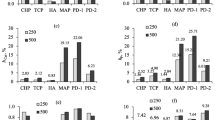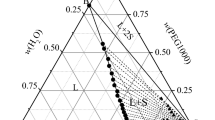Abstract
Inverse gas chromatography at infinite dilution was applied to determine the thermodynamic interactions of poly(l-lactide) (PLLA) and the composite of biphasic calcium phosphate and PLLA (BCP/PLLA). The specific retention volumes, \( V_{\text{g}}^{0} \), of 11 organic compounds of different chemical nature and polarity (non-polar, donor or acceptor) were determined in the temperature range of 308–378 K for PLLA and 308–398 K for BCP/PLLA. The weight fraction activity coefficients of test sorbates, \( \Omega_{1}^{\infty } \), and the Flory–Huggins interaction parameters, \( \chi_{12}^{\infty } \), were estimated and discussed in terms of interactions of the sorbates with PLLA and BCP/PLLA. Also, the partial molar free energy, \( \Delta G_{1}^{\infty } \), the partial molar heat of mixing, \( \Delta H_{1}^{\infty } \), the sorption molar free energy, \( \Delta G_{1}^{\text{S}} \), the sorption enthalpy, \( \Delta H_{1}^{\text{S}} \), and the sorption entropy, \( \Delta S_{1}^{\text{S}} \), were analyzed. A different chromatographic behavior of the two investigated samples, PLLA and BCP/PLLA, was observed. The values of \( \Omega_{1}^{\infty } \) indicated n-alkanes, diethyl ether, tetrahydrofurane (THF), cyclohexane, benzene, dioxane (except for 338 K), and ethyl acetate (EtAc) (except for 338 K) as non-solvents, and chloroform (CHCl3) as good solvent (except for 378 K) for PLLA. For BCP/PLLA, CHCl3, EtAc (for 378 K), dioxane (except for 378 K), and THF were indicated as good solvents.







Similar content being viewed by others
References
Roeder RK, Converse GL, Kane RJ, Yue W (2008) Hydroxyapatite-reinforced polymer biocomposites for synthetic bone substitutes. JOM 60:38–45
Zhou H, Lawrence JG, Bhaduri SB (2012) Fabrication aspects of PLA-CaP/PLGA-CaP composites for orthopedic applications: a review. Acta Biomater 8:1999–2016
Ignjatović N, Plavšić M, Miljković M, Živković LJ, Uskoković D (1999) Microstructural characteristic of Ca-hydroxyapatite/poly-l-lactide based composites. J Microsc 196:243–248
Nazhat SN, Kellomäki M, Törmälä P, Tanner KE, Bonfield W (2001) Dynamic mechanical characterization of biodegradable composites of hydroxyapatite and polylactides. J Biomed Mater Res 58:335–343
Roeder RK, Sproul MM, Turner CH (2003) Hydroxyapatite whiskers provide improved mechanical properties in reinforced polymer composites. J Biomed Mater Res A 67:801–812
Ignjatović N, Tomić S, Dakić M, Miljković M, Plavšić M, Uskoković D (1999) Synthesis and properties of hydroxyapatite/poly-l-lactide composite biomaterials. Biomaterials 20:809–816
Furukawa T, Matsusue Y, Yasunaga T, Shikinami Y, Okuno M, Nakamura T (2000) Biodegradation behavior of ultra-high-strength hydroxyapatite/poly (l-lactide) composite rods for internal fixation of bone fractures. Biomaterials 21:889–898
Ajduković Z, Najman S, Đorđević LJ, Savić V, Mihailović D, Petrović D, Ignjatović N, Uskoković D (2005) Repair of bone tissue affected by osteoporosis with hydroxyapatite/poly-l-lactide (HAp-PLLA) with and without blood plasma. J Biomater Appl 20:179–190
Dorozhkin SV (2009) Calcium orthophosphate-based biocomposites and hybrid biomaterials. J Mater Sci 44:2343–2387
Uskoković V, Uskoković D (2011) Nanosized hydroxyapatite and other calcium phosphates: chemistry of formation and application as drug and gene delivery agents. J Biomed Mater Res Part B 96B(152):152–191
Russias J, Saiz E, Nalla RK, Tomsia AP (2006) Microspheres as building blocks for hydroxyapatite/polylactide biodegradable composites. J Mater Sci 41:5127–5133. doi:10.1016/j.actbio.2008.04.006
Middleton JC, Tipton AJ (2000) Synthetic biodegradable polymers as orthopedic devices. Biomaterials 21:2335–2346
Ignjatović NL, Liu CZ, Czernuszka JT, Uskoković DP (2007) Micro and nano/injectable composite biomaterials of calcium phosphate coated with poly(dl-lactide-co-glycolide). Acta Biomater 3:927–935
Shikinami Y, Okuno M (1999) Bioresorbable devices made of forged composites of hydroxyapatite (HA) particles and poly-l-lactide (PLLA): part I basic characteristics. Biomaterials 20:859–877
Surrao DC, Waldman SD, Amsden BG (2012) Biomimetic poly(lactide) based fibrous scaffolds for ligament tissue engineering. Acta Biomater 8:3997–4006
Jung MR, Shim IK, Kim ES, Park YJ, Yang YI, Lee SK, Lee SJ (2011) Controlled release of cell-permeable gene complex from poly(l-lactide) scaffold for enhanced stem cell tissue engineering. J Control Release 152:294–302
Verheyen C, Klein C, de Blieckhogervorst J, Wolke J, van Blitterswijn C, de Groot K (1993) Evaluation of hydroxyapatite/poly(l-lactide) composites: physicochemical properties. J Mater Sci Mater Med 4:58–65
Fabbri M, Celotti G, Ravaglioli (1995) A hydroxyapatite-based aggregates: physico-chemical nature, structure, texture and architecture. Biomaterials 16:225–228
Ignjatović N, Suljovrujić E, Budinski-Simendić J, Krakovsky I, Uskoković D (2004) Evaluation of hot-pressed hydroxyapatite/poly-l-lactide composite biomaterial characteristics. J Biomed Mater Res Part B 71B:284–294
Ignjatović N, Ninkov P, Ajduković Z, Vasiljević-Radović D, Uskoković D (2007) biphasic calcium phosphate/poly-d,l-lactide-co-glycolide composite biomaterial as bone substitute. J Eur Ceram Soc 27:1589–1594
Lloyd DR, Ward TC, Schreiber HP (1989) Inverse gas chromatography. Characterization of Polymers and other materials. ACS Symposium Series, 391 Washington, DC
Conder JR, Young CL (1979) Physicochemical measurements in gas chromatography. Wiley, New York
Kaya I, Ilter Z, Senol D (2002) Thermodynamic interactions and characterisation of poly[(glycidyl methacrylate-co-methyl, ethyl, butyl) methacrylate] by inverse gas chromatography. Polymer 43:6455–6463
Reid RC, Prausnitz JM, Sherwood TK (1977) The properties of gases and liquids. Mc Graw-Hill, New York
DiPaola-Baranyi G, Guillet JE (1978) Estimation of polymer solubility parameters by gas chromatography. Macromolecules 11:228–235
Voelkel A, Strzemiecka B, Adamska K, Milczewska K (2009) Inverse gas chromatography as a source of physiochemical data. J Chromatogr A 1216:1551–1566
Zhao L, Choi P (2001) Determination of solvent-independent polymer–polymer interaction parameter by an improved inverse gas chromatographic approach. Polymer 42:1075–1081
Huang JC (2006) Anomalous solubility parameter and probe dependency of polymer–polymer interaction parameter in inverse gas chromatography. Eur Polym J 42:1000–1007
Panayiotou C (2013) Polymer–polymer miscibility and partial solvation parameters. Polymer 54:1621–1638
Héberger K, Milczewska K, Voelkel A (2005) Principal component analysis of polymer–solvent and filler–solvent interactions by inverse gas chromatography. Colloids Surf A 260:29–37
Hamieh T, Fadlallah MB, Schultz J (2002) New approach to characterize physicochemical properties of solid substrates by inverse gas chromatography at infinite dilution: III. Determination of the acid–base properties of some solid substrates (polymers, oxides and carbon fibres): a new model. J Chromatogr A 969:37–47
Nastasović AB, Onjia A, Milonjić SK, Jovanović SM (2005) Surface characterization of macroporous glycidyl methacrylate based copolymers by inverse gas chromatography. Eur Polym J 41:1234–1242
Cava D, Gavara R, Lagarón JM, Voelkel A (2007) Surface characterization of poly(lactic acid) and polycaprolactone by inverse gas chromatography. J Chromatogr A 1148:86–91
Hamieh T, Schultz J (2002) New approach to characterize physicochemical properties of solid substrates by inverse gas chromatography at infinite dilution: II. Study of the transition temperatures of poly(methyl methacrylate) at various tacticities and of poly(methyl methacrylate) adsorbed on alumina and silica. J Chromatogr A 969:27–36
Nastasović AB, Onjia AE, Milonjić SK, Jovanović SM (2005) Determination of thermodynamic properties of macroporous glycidyl methacrylate-based copolymers by inverse gas chromatography under finite surface coverage. J Polym Sci Part B 43:2524–2533
Benabdelghani Z, Etxeberria A, Djadoun S, Iruin JJ, Uriarte C (2006) The phase behaviour of poly(styrene-co-methacrylic acid)/poly(2,6-dimethyl-1,4-phenylene oxide) by inverse gas chromatography. J Chromatogr A 1127:237–245
Nastasović AB, Onjia A (2008) Determination of glass temperature of polymers by inverse gas chromatography (review). J Chromatogr A 1195:1–15
Zhong B, Al-Saigh ZY (2012) Characterization of biodegradable polymers by inverse gas chromatography. III. Blends of amylopectin and poly(l-lactide). J Appl Polym Sci 123:2616–2627
Eser H, Tihminlioglu F (2006) Determination of thermodynamic and transport properties of solvents and non solvents in poly(l-lactide-co-glycolide). J Appl Polym Sci 102:2426–2432
Al-Saigh ZY (1999) Inverse gas chromatographic characterization of poly(ethylene oxide). Polymer 40:3479–3485
Miličević D, Trifunović S, Dojčilović J, Ignjatović N, Suljovrujić E (2010) The influence of gamma radiation on the molecular weight and glass transition of PLLA and HAp/PLLA nanocomposite. Nucl Instrum Methods Phys Res Sect B 268:2744–2749
Fox TG, Flory PJ (1948) Viscosity-molecular weight and viscosity-temperature relationships for polystyrene and polyisobutylene. J Am Chem Soc 70:2384–2395
Qian R, Wu L, Shen D, Napper DH, Mann RA, Sangster DF (1993) Single-chain polystyrene glasses. Macromolecules 26:2950–2953
Liao K, Quan D, Lu Z (2002) Effects of physical aging on glass transition behavior of poly(dl-lactide). Eur Polym J 38:157–162
Lavoie A, Guillet JE (1969) Estimation of glass transition on temperatures from gas chromatographic studies on polymers. Macromolecules 2:443–446
Davis PK, Danner RP, Duda JL, Romdhane IH (2004) Use of inverse gas chromatography to study binary polymer–solvent systems near the glass transition temperature. Macromolecules 37:9201–9210
Ignjatović N, Nastasović A, Laninović V, Onjia A, Miljković M (2004) Preparation and properties of polymeric and composite bioresorbable barrier membranes. Mater Sci Forum 453–454:537–542
Milczewska K, Voelkel A (2002) Characterization of the interactions in polymer-filler systems by inverse gas chromatography. J Chromatogr A 969:255–259
Guillet JE, Purnell JH (1973) Advances in analytical chemistry and instrumentation gas chromatography. Wiley, New York
Flory PJ (1953) Principles of polymer chemistry. Cornell University Press, New York
Santos JMRCA, Guthrie JT (2005) Analysis of interactions in multicomponent polymeric systems: The key-role of inverse gas chromatography. Mater Sci Eng R 50:79–107
Liu Y, Shi B (2008) Determination of Flory interaction parameters between polyimide and organic solvents by HSP theory and IGC. Polym Bull 61:501–509
Voelkel A (2012) Physicochemical measurements (inverse gas chromatography). In: Poole CF (ed) Gas chromatography. Elsevier, Amsterdam, pp 477–494
Barton AFM (1991) CRC handbook of solubility parameter and other cohesion parameters. CRC Press, Boca Raton
Blanks RF, Prausnitz JM (1964) Thermodynamics of polymer solubility in polar and nonpolar systems. Ind Eng Chem Fundam 3:1–8
Klein J, Jeberien HE (1980) Chainlength dependence of thermodynamic properties of poly(ethylene glycol). Macromol Chem 181:1237–1249
Acknowledgements
This work was funded by the Serbian Ministry of Education, Science and Technological Development through the projects III43009 and III45004. The authors thank Novartis Pharma AG (Basel, Switzerland) for their donation of the HP5890II gas chromatograph used in this work.
Author information
Authors and Affiliations
Corresponding author
Rights and permissions
About this article
Cite this article
Nastasović, A.B., Ignjatović, N.L., Uskoković, D.P. et al. Determination of thermodynamic interactions of poly(l-lactide) and biphasic calcium phosphate/poly(l-lactide) composite by inverse gas chromatography at infinite dilution. J Mater Sci 49, 5076–5086 (2014). https://doi.org/10.1007/s10853-014-8214-3
Received:
Accepted:
Published:
Issue Date:
DOI: https://doi.org/10.1007/s10853-014-8214-3




